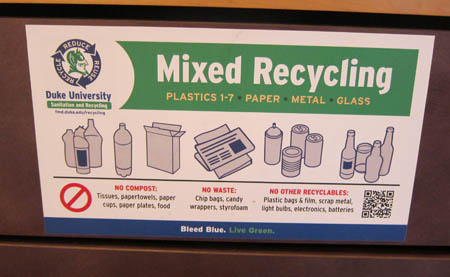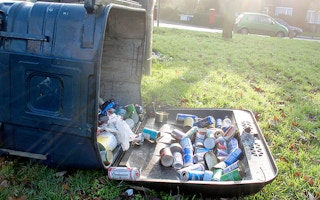It’s “sweeping the country,” but does it lead to more recycled material and less trash in the landfill?
I live in Durham, North Carolina, but spend some time in New York City. In my NYC digs I recycle the old-fashioned way — separating plastics, paper and glass, and throwing them into separate bins.
But in Durham I just toss everything into a single cart and put the cart by the sidewalk every other week. From there, a truck picks it up and hauls it away, the plastic, paper and glass all jumbled together. And jumbled together they stay until arriving at a materials recovery facility (or MRF, pronounced MURF) where everything is separated out into its various recyclable and unrecyclable components.
From some descriptions I’ve read, these plants with their “magnets, ballistic air separators, optical container sorters and aluminum eddy current systems” must be a Rube Goldberg fantasy come true.
In the trash biz, we say that NYC uses multi-stream recycling while Durham uses single stream.
To be honest, I never really thought that much about the advantages or disadvantages of single-stream over multi-stream recycling. Sure, my Durham persona appreciates the simplicity of single-stream recycling, but my NYC persona doesn’t find the task of separating recyclables into separate bins all that arduous and so it was pretty much a wash for me.
“
We’re confident that making the switch to single-stream recycling will help us better capture the 40 per cent recycling that was put in the trash
Arwen Buchholz, Duke University recycling and waste reduction coordinator
And then earlier this month I read that Duke University, my very own academic home, was moving to single-stream recycling in a new pilot project that would also include collecting compostables. The compostables thing is a great idea — see my post — but what about single-stream recycling, I wondered? Arwen Buchholz, Duke’s recycling and waste reduction coordinator, is pretty sanguine about it, stating that “we’re confident that making the switch to single-stream recycling will help us better capture the 40 per cent recycling that was put in the trash.”
Wow, 40 per cent is a lot. Is it really that much? I decided to do a little digging on my own.
America recycles
We’ve come a long way, baby, as far as recycling in the United States goes. In 1990 we recycled about 33 million tons and 16 per cent of our solid waste. By 2011 (the last year for which the Environmental Protection Agency has data), that amount had jumped more than 2.5 times to ~87 million tons, diverting 35 per cent of our waste stream with more than 60 per cent of Americans having access to curbside recycling.
Part of that growth has apparently come from the advent of single-stream recycling.
The single-stream rush
Material recovery processing plants equipped to handle single-stream recycling appeared on the US scene in the mid-1990s, and jumped from just a handful in 1995 to 93 in 2003. While recent estimates of the number of such facilities differ (e.g., 200 in 2009 or more than 160 in 2011) the growth in single-stream processing facilities has clearly come at the expense of multi-stream programs. In 2005 20 per cent of recycling communities used single-stream, but by 2010, that had grown to 64 per cent. At the same time communities using multi-stream recycling decreased by a similar amount, from 70 per cent to 34 per cent over the same period.
Why the switch to single stream? Many experts say it’s a no-brainer. For one it allows municipalities “to increase recycling volumes and reduce high recycling collection costs.” *According to the Solid and Hazardous Waste Education Center at the University of Wisconsin, single-stream recycling reduces these costs by five to 25 per cent. And single stream, it is claimed, encourages residents to put more stuff in the recycling bin for collection (see here, here and here). Why? Presumably, because it’s more convenient and because residents are given a larger container to cram their stuff into. In the words of one waste and recycling service touting single stream: “With a recycling container that is much larger than that old curbside bin, you can recycle more and waste less!” (Their exclamation point.)
Another service reports that single-stream recycling “encourages people to recycle more.” Greener Pittsburgh claims that “[o]n average, at least 50 per cent more recyclables are collected with single-stream recycling.” And Waste Management, Inc., the king of all things left at the curb or in a large container behind Wal-Mart, claims that “the simplicity of this approach has been shown to increase recycling rates an average of 30 per cent.”

Single-stream recycling is taking off in the United States, but I wonder how that’s affecting what’s getting recycled and how much is reaching the landfill … and how much we pay for goods. |
Those are impressive numbers and tend to confirm the 40 per cent number cited by Duke’s Arwen Buchholz, but those are not the only numbers out there. There are those that have come to very different conclusions. One such individual is Daniel Lantz, the director of environmental and engineering services at Metro Waste Paper in Toronto. He claims [pdf] that increases seen in collection rates when locales switch “may not be solely due to the single-stream collection system, but rather due to a combination of factors [such as] … increased promotion.” And this claim is supported by other studies [pdf] that find that increased collections can also be had with dual-stream programs. For example, the city of Berkeley in California was able to increase its tonnage and keep a dual-stream by providing larger carts.
But let’s leave the question of increased collection aside and consider another issue: how much material actually gets recycled versus how much ends up in a landfill. Just because more stuff gets collected in the recycling bin doesn’t mean more stuff gets recycled. And there is a good deal of data to suggest that it does not.
Garbage in doesn’t mean recyclables out
It probably does not surprise you to learn that not all the stuff we place in recycling bins is actually recyclable; and not all the recyclable material in those bins gets properly sorted out and sent on its recycling way. The stuff that shouldn’t have been put in the bin and the stuff that could have been recycled and wasn’t are known as residuals and it all gets sent to landfill. And guess what: single-stream systems generally produce a lot more residuals than multi-stream. According to the Solid and Hazardous Waste Education Center, residual rates [pdf] are roughly one per cent for multi-steam systems, two to three per cent in dual-stream systems, and a whopping 15 to 27 per cent for single-stream systems.
That’s right: More than 10 times more residuals come from single-stream systems than multi-stream. Still, all things being equal, if collections in single-stream systems are 50 per cent larger (and as noted above, that’s a big if), single stream is still a winner even if 20 percent more goes to the landfill. But wouldn’t you know it, all things are not equal.
“
Below the surface of all the hoopla on the joys of single-stream recycling there is a lot of doubt and skepticism. There are a fair number of people in the industry who have done the math and are not convinced that it makes sense
Bill Chameides
Downcycling instead of recyclables
Once stuff leaves the recycling plant, it heads to re-processors, paper mills and bottle makers who use the material to make new products. The re-processors don’t just care about quantity, they care about quality. If the recycled material is of inferior quality, they’ve got problems. And it would appear that many in the re-processing business are none too happy about single-stream recycling.
For example this from a 2010 report [pdf] by the Container Recycling Institute: “Ask any post-consumer materials processor about single-stream collection and it’s more than likely they will tell you that handling commingled [single-stream] recyclables is problematic.” The reason is simple: the quality of the material they receive from single-stream recyclers is inferior, which forces the manufacturer to downcycle the material (i.e., use it in a cheaper product) or, even worse, send it to the landfill. For example, the same institute reports: “On average, 40 per cent of glass from single-stream collection winds up in landfills, while 20 per cent is small broken glass … used for low-end applications. Only 40 per cent is recycled into containers and fiberglass.”
Another report [pdf] indicates that yields of recyclable plastics have gone from 75-78 per cent for dual stream to 68-70 per cent for single stream. (Deposit systems give the best yield of about 85 per cent.)
Does it really pay?
So I said at the beginning of the post that I was going to do a little digging and what I’ve found is that just below the surface of all the hoopla on the joys of single-stream recycling there is a lot of doubt and skepticism. There are a fair number of people in the industry who have done the math and are not convinced that it makes sense. (See here [pdf], here [pdf], and here [pdf].)
So why the rush to single-stream recycling? Could it be that it’s cheaper for a municipality (or for a university) to run a single-stream operation? If so, the question we need to ask ourselves is if those are real savings. Certainly not for the re-processors: “The cost savings for a municipality from single-stream collection show up as cost increases for the processors and recyclers.” And if the processor and recyclers are paying more, so are we consumers. But the real concern is the landfill. I would hate to think we’re saving money for municipalities and paying the price at the landfill.
______________
End Note
*Studies [pdf] show that increased collections can also be had with dual-stream programs. For example, the city of Berkeley in California was able to increase its tonnage and keep a dual-stream by providing larger carts.
Bill Chameides is the dean of Duke University’s Nicholas School of the Environment. Crossposted with The GreenGrok. This post originally appeared here.










